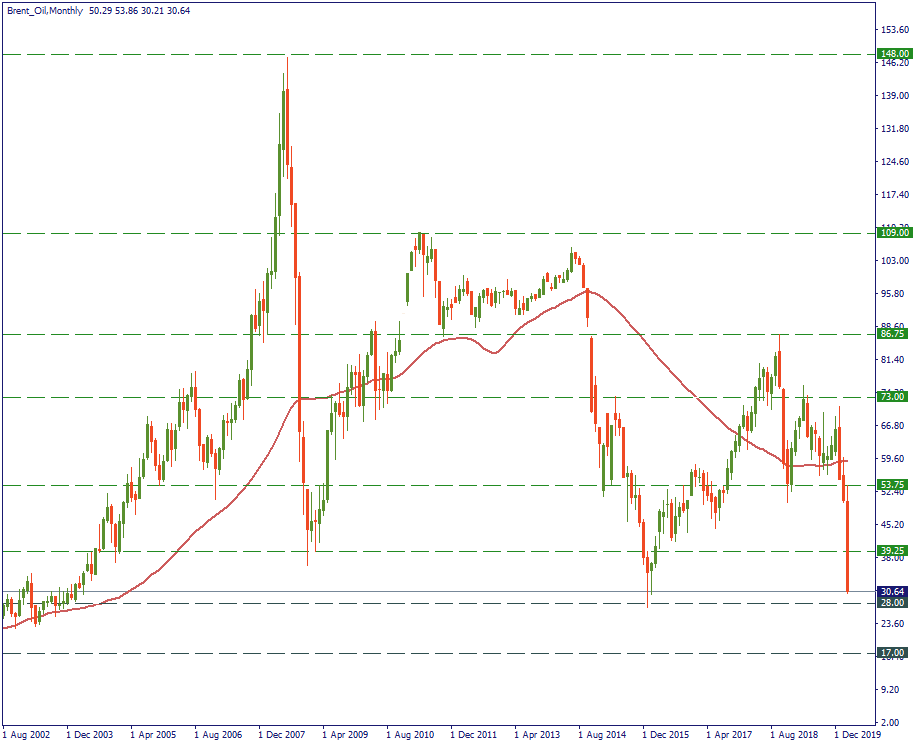
Dua tahun ini, kita menyaksikan pergerakan harga minyak terbesar dalam tempoh 14 tahun, yang membingungkan pasaran, pelabur dan pedagang akibat ketegangan geopolitik dan peralihan ke tenaga bersih.
2020-03-17 • Dikemaskini
Oil now trades at extremely low prices but that’s nothing new already – not anymore. Its price is at $30 per barrel testing the January-2016 low of $28 and eyeing the ranges of $16 from 2001. These numbers alone are historical enough and we have been witnessing them since the failed reunion of OPEC+ on March 5. So what exactly is affecting the oil price? And where it is likely to go?

The first factor that obviously drags the oil price down is the looming drop in demand because of the coronavirus. The logic is quite straightforward: countries lockdown populations, switch off the provision of services and transportation channels, ban public gatherings and limit total activity – all of that lowers and limits economic activity. Under this condition, the projected consumption of oil will be lower than planned before – much lower. Financial observers keep revising their demand projections down: a week ago, it was 100000bpd drop in global daily demand; now, the talk is about the ranges of 1mln. This is a rare case when a fundamental factor gains such an acceleration of change. Global oil demand is collapsing and dragging the oil price down.
Saudi Arabia and Russia are in a state of oil war. Both are adamant about intentions to increase the output. Tactically, the two will be battling over the European market: Saudi Arabia to conquer it, Russia to keep it. Strategically, the countries will be testing the economic resilience of each other: the one which is able to keep the internal economic integrity under the pressure of low oil prices should win. Of the two, Saudi Arabia has the upper hand in terms of spare capacity for production increase (its last pledge was another 2.6mln barrels a day on top of the current production), but Russia has more economic might to survive the war in the long run. As long as the war goes on, its main cog is the escalation of the oil supply. Even in the world without the virus, this factor alone puts the oil price under pressure.
The KSA-Russian oil war has two components: oil output, which affects the price, and the price which is directly set by crude producers of both countries. As such, it is applicable more to Saudi Arabia as it stroke the specifically the European market with the unseen discounts on its crude, using the price as very painful leverage against Russia. But Russia is not the only one who suffers the inflicted damage. On the other side of the globe, this competition will force the US shale producers to count days before they exhaust their financial safe-kits and go bankrupt one by one. They will not be able to tolerate the unbearable cheapness of Saudi and Russian crude and will leave the field, with the exception of the industry giants such as Chevron or Exxon. At the moment, Saudi Arabia’s short-term interest is to keep the oil price as low as possible to rule out any possibility for Russia to be a contender. As a state interestб that becomes a separate factor pressing on the price.
Therefore, we have now three factors pressing on the oil price separately, but in relation to each other: dropping global demand, rising supply, and direct state policy. Combined together, they leave no choice for the oil price but to tremble at the ranges of $25-30 per barrel and fear falling further. Most probably, the next chapter of this epic will start on April 1, after the current output restriction agreed in December by OPEC+ (now obsolete) ends its term. Until then, watch it go sideways within the current corridor ($27 – 35 for WTI). Times like this may not come in a decade, so prepare well for oil price war stage 2.

Dua tahun ini, kita menyaksikan pergerakan harga minyak terbesar dalam tempoh 14 tahun, yang membingungkan pasaran, pelabur dan pedagang akibat ketegangan geopolitik dan peralihan ke tenaga bersih.

Selepas beberapa bulan menerima tekanan dari Rumah Putih, Arab Saudi mengalah dan bersetuju untuk meningkatkan pengeluaran bersama dengan ahli-ahli OPEC+ yang lain.

Pada hari Khamis, 2 Jun, Pertubuhan Negara-Negara Pengeksport Petroleum Plus (OPEC+) telah bersetuju untuk meningkatkan pengeluaran sebanyak 648,000 tong sehari (bpd) pada bulan Julai dan Ogos.

Fed mengumumkan pada hari Rabu bahawa ia membiarkan kadar dasar tidak berubah pada 5…

Jepun melangkah lebih dekat kepada campur tangan mata wang dengan amaran terkuatnya apabila yen merosot ke paras paling lemah dalam kira-kira 34 tahun berbanding dolar…

Sentimen pasaran yang memulih pada pembukaan dagangan awal minggu semalam telah menukar semula haluan pergerakan USD…
FBS menyimpan rekod data anda untuk mengoperasikan laman web ini. Dengan menekan butang "Terima", anda menyetujui Polisi Privasi kami.
Permohonan anda telah diterima
Pengurus akan menghubungi anda dalam amsa terdekat
Permohonan panggil balik seterusnya untuk nombor telefon ini
boleh dilakukan dalam dalam
Jika anda mempunyai isu yang perlu disegerakan, sila hubungi kami menerusi
Live Chat
Masalah dalaman. Sila cuba sebentar lagi
Jangan bazir masa anda – pantau bagaimana NFP mempengaruhi dolar AS dan kaut keuntungan!
